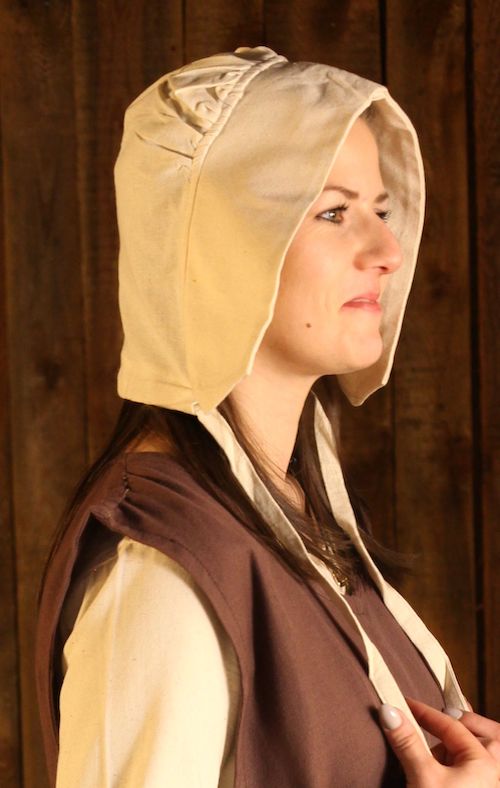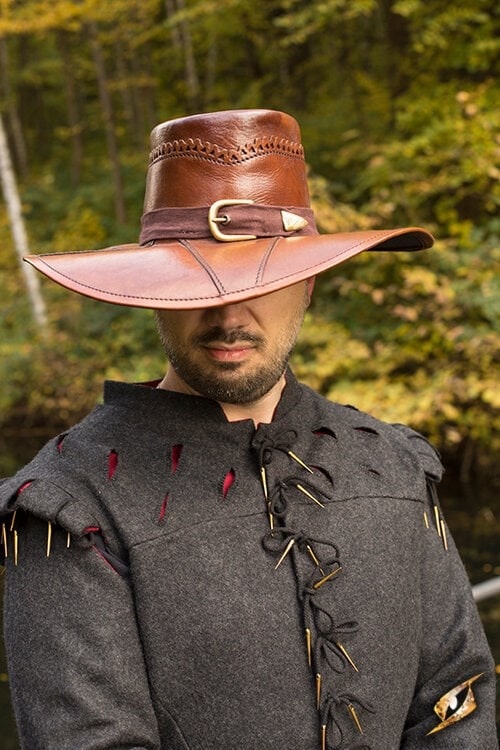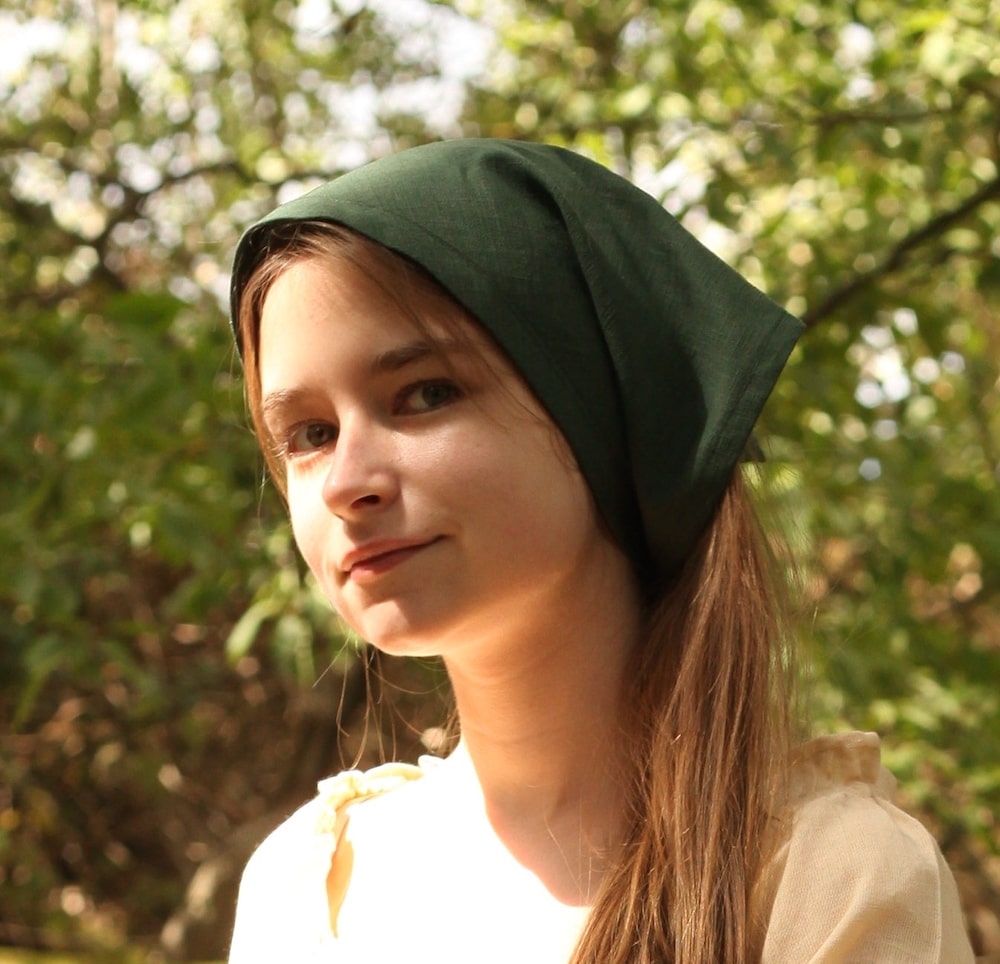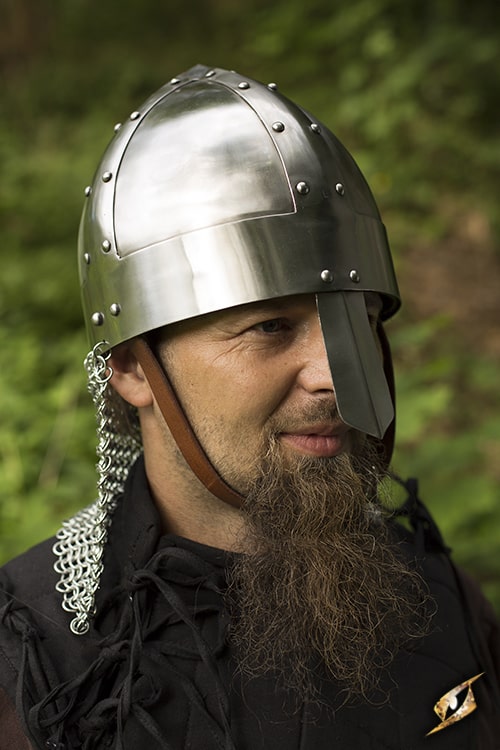The most beautiful headgear for your garb
 Here in the online shop of LARP-Fashion.co.uk you will find everything your heart desires to appear at a LARP or medieval market in keeping with the times and your status. On this page you have arrived at the headgear. Find your bonnet, cap, hat or helmet here. As always in our shop, we have taken great care in the selection. In addition, we always make sure that each item is of good quality at a fair price. We want you to be happy for a long time when you dress yourself from head to toe.
Here in the online shop of LARP-Fashion.co.uk you will find everything your heart desires to appear at a LARP or medieval market in keeping with the times and your status. On this page you have arrived at the headgear. Find your bonnet, cap, hat or helmet here. As always in our shop, we have taken great care in the selection. In addition, we always make sure that each item is of good quality at a fair price. We want you to be happy for a long time when you dress yourself from head to toe.
Headgear in the Middle Ages
To make a LARP costume for the Middle Ages as realistic as possible, it is important to include many details in your outfit. Only then can you create a coherent overall picture that will delight every fellow player and LARP fan. A matching headdress can add the finishing touch to your own role. Headgear says a lot about the status of your character. A velvet hair wreath with a veil, for example, indicates a high pedigree. A plain bonnet suggests the status of a commoner. With a matching bonnet or other medieval headgear, one wears a sign, so to speak. Of course, there was also the hat in the Middle Ages, which was designed with sometimes adventurous shapes. However, such a hat was very expensive because it required a lot of effort. You have it better today!
Medieval headgear for gentlemen, adventurers and knights
 The common people rarely wore headgear in the Middle Ages. Firstly, it was expensive, and secondly, it was a hindrance to hard work. So if a peasant wanted to protect or even decorate his head, he wove a hat out of straw or wore a cap made of felt. Later, the church also prescribed head coverings in order to appear nicely mannered and chaste. But the priest rarely appeared in the field or on the farm. It was different, however, with the lords or knights. In the Middle Ages, a knight or adventurer had to be perfectly prepared for battle at almost any time.
The common people rarely wore headgear in the Middle Ages. Firstly, it was expensive, and secondly, it was a hindrance to hard work. So if a peasant wanted to protect or even decorate his head, he wove a hat out of straw or wore a cap made of felt. Later, the church also prescribed head coverings in order to appear nicely mannered and chaste. But the priest rarely appeared in the field or on the farm. It was different, however, with the lords or knights. In the Middle Ages, a knight or adventurer had to be perfectly prepared for battle at almost any time.
Therefore, in the Middle Ages, one could not skimp on the appropriate armour. The helmet must of course be mentioned here in the first place. Today, of course, your Character at the LARP decides which helmet you choose. There is the Barbuta, Raven helmet, Persian helmet, Nasal helmet or even the Assassin helmet. All of these headdresses look splendid. The Middle Ages always meant heavy blows and danger even with minor injuries. Therefore, the head had to be protected from all blows even under the helmet. Thus, in the Middle Ages, a bonnet made of cloth or thick felt was very important under the helmet. By the way, with this the fight can still be so wild on the LARP - injuries are at least limited.
After the fight, you can wear a black leather hat and go to the next tavern to celebrate the great victory. The looks of the ladies were magically attracted to the fancy hats in the Middle Ages just as they are today at the LARP. With these, every adventurer immediately makes a grand entrance. Depending on the shape of the head and the hairstyle, the beret can also be a very decorative outfit.
Medieval headgears for maidens and noblewomen
 With a handsome bonnet or a chic triangular scarf, the lady or warrior from the Middle Ages completes her outfit. In contrast to a simple cap, such a bonnet, like the beret, could be very elaborately designed and decorated. In the Middle Ages, therefore, the bonnet and veil were headgear for the higher classes. As a coif or waistcoat, the bonnet was made of white linen. In the version for armour in the Middle Ages, the bonnet was made as a coif with chain links and served as a substitute for the helmet. Incidentally, the beret, which is still known today, was worn by men as well as women, ladies as well as gentlemen, just like the gugel. The beret was a kind of flat cap, the brim of which could be extremely ornate depending on the rank. The beret for noblewomen could be made of velvet and silk and was decorated with brooches or even ostrich feathers. Today, as in the Middle Ages, the costume or clothing does not only look good through jewellery or the matching medieval dress. Only with the authentic headdress does the appearance become a real eye-catcher.
With a handsome bonnet or a chic triangular scarf, the lady or warrior from the Middle Ages completes her outfit. In contrast to a simple cap, such a bonnet, like the beret, could be very elaborately designed and decorated. In the Middle Ages, therefore, the bonnet and veil were headgear for the higher classes. As a coif or waistcoat, the bonnet was made of white linen. In the version for armour in the Middle Ages, the bonnet was made as a coif with chain links and served as a substitute for the helmet. Incidentally, the beret, which is still known today, was worn by men as well as women, ladies as well as gentlemen, just like the gugel. The beret was a kind of flat cap, the brim of which could be extremely ornate depending on the rank. The beret for noblewomen could be made of velvet and silk and was decorated with brooches or even ostrich feathers. Today, as in the Middle Ages, the costume or clothing does not only look good through jewellery or the matching medieval dress. Only with the authentic headdress does the appearance become a real eye-catcher.
 The change of headgear in LARP
The change of headgear in LARP
With a well-chosen medieval headdress, an outfit can be adapted for almost any role. In addition, headgear allows you to change your appearance quickly. With a selection of different headdresses, you can always recreate your own role. In addition to the cap and bonnet, other medieval headgear for women included the towering hennin, the bannister, the veil or the hairnet. The hennin was the "bonnet of the Burgundians" and was elaborately made of whalebone or wire. The hairnet, on the other hand, was made of cotton, silk or thick threads.
The hairnet was usually very sumptuously decorated - with pearls or precious stones. The so called wimple was rather ornamental and otherwise quite useless. Also called gimple, the wimple consisted of a linen cloth that covered the entire head and was pulled tight as a bandage under the chin. This may have been chic, but it hindered the demure ladies when eating as well as when speaking.
Medieval headgear can be as practical as it is decorative
Especially on cooler days, headgear is important for one's well-being and health. To be well dressed at a LARP event even in autumn or winter, the hat or cap should be medieval in style. Only then the event can be truly authentic. However, a simple cap is not enough to keep the head warm. Here we also have to mention the cowl. We have found a place for cotton guilds in the capes and cloaks section. Nevertheless, the gugel also passes for headgear from the Middle Ages. At least in the cold season, the gugel was an important part of clothing for some estates and certainly for travellers. The gugel is always more practical and decorative on the LARP than, for example, a bobble hat. It is too bad if the atmosphere is disturbed by unsuitable woolly hats or even earmuffs. A smart leather hat, a gugel or a woollen bonnet reliably warms the head and is also a wonderful accessory for your own clothing.